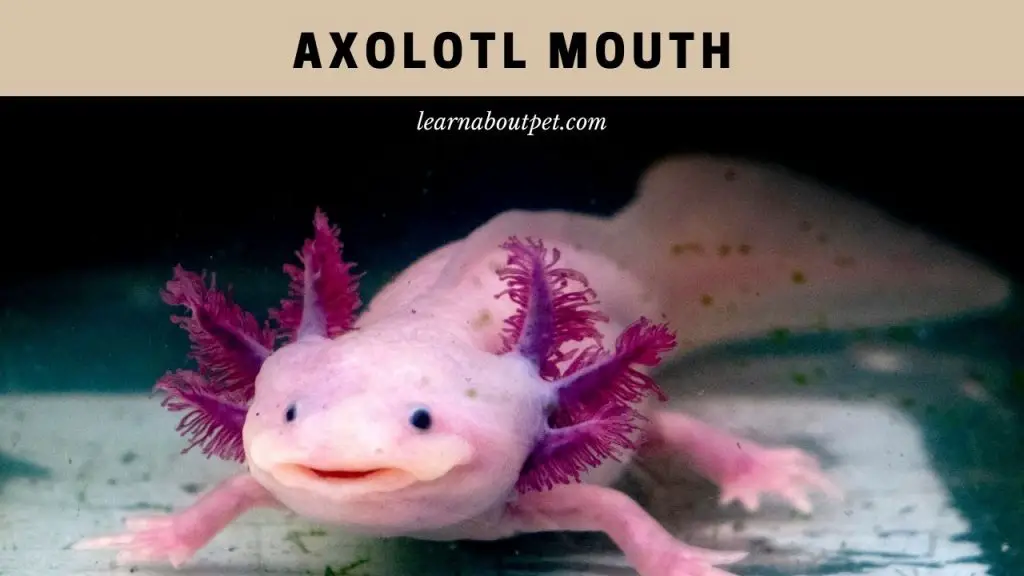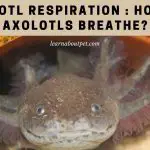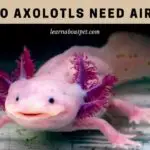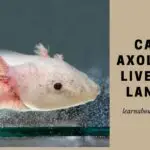For most people, the most fascinating part of an axolotl is its mouth. People often express interest in knowing what is inside the axolotl’s mouth, whether it can bite, what an axolotl with an open mouth means… and so on. This article explores all those issues.
The axolotl mouth is mainly for eating. But where an axolotl needs to breathe via its lungs, it gulps the air (on the tank surface) using its mouth. An axolotl can bite, but its bite is usually painless and not harmful to a human. An axolotl’s mouth may remain open due to injuries, illnesses, deformities or being in poor water conditions.
In the axolotl’s scientific name (Ambystoma mexicanum), the ‘ambystoma’ part is actually a reference to its cup-like mouth. Thus, the axolotl big mouth is actually the source of its scientific name!

What Do Axolotls Use Their Mouths For?
The main purpose that axolotls use their mouth for is that of eating. Normally, when an axolotl detects the presence of something that can be food for it, it snaps at it using its mouth.
Then it directs it inwards using the tiny teeth that are in the mouth. Thereafter, it swallows whatever food is in question whole, and proceeds to digest it as necessary.
The secondary purpose of the axolotl’s mouth may be that of breathing. But it is worth noting that axolotls primarily take in the oxygen they need through their gills.
Thus, it is only rarely (sometimes when something is quite wrong) that an axolotl will come to the surface of the tank it is staying in, and gulp for air through its mouth.
In the latter case, where the axolotl gulps for air using its mouth, the respiration is via its lungs. So an axolotl has both functional gills and lungs, though the lungs tend to be rather rudimentary.
All in all, in an axolotl, the mouth is for eating and occasionally for breathing.
That answers the what do axolotls have mouths for question.
But this is with regard to real life axolotl animals. The axolotl mouth minecraft enthusiasts deal with (in the video games) may have other purposes.
Therefore the eating and occasional breathing functions are for the real-life axolotl’s mouth. Not for the minecraft axolotl mouth.
How Big Is Axolotl Mouth Size?
The axolotl’s mouth is rather big, relative to its size. As noted earlier, it is actually from its ‘cup-mouth’ that the axolotl gets the first part of its scientific name.
In an adult axolotl, if you measure from one end of the mouth to the other (the circumference), it may be 2-3 inches.
And that is a rather big mouth, relative to the axolotl’s head size.
What Is Inside Axolotl Mouth?
Inside the axolotl’s mouth are some rudimentary teeth. These are not for chewing, but rather, for directing food inwards when swallowing.
The other thing that is inside the axolotl’s mouth is a tongue. But this is not a flexible tongue, like the human tongue. It is a fixed tongue, similar to what we see in fish.
What Is Normal Axolotl Tongue Color?
A normal axolotl tongue may be light pink. But there are also those who may still find a deeper hue of pink normal…
What is certainly abnormal is, say, a case where you find the axolotl mouth black.
Such axolotl black mouth may be due to an infection – something like infectious stomatitis.
Others cause for abnormal color in axolotl’s mouth include axolotl mouth rot, axolotl mouth fungus infections and so on.
Therefore whenever you find your axolotl with funny looking mouth, yet it is usually normal, it should be cause for concern.
Even finding a red spot on axolotl mouth should arouse questions.

Do Axolotls Bite?
Yes, axolotls do bite. If, for instance, you keep your finger near the axolotl’s mouth, it may snap at it and proceed to bite it.
Thankfully, an axolotl bite is not painful. That is because the axolotl’s teeth are not strong enough to inflict much pain.
Neither is the axolotl bite particularly harmful, as it is not known to be toxic.
What Happens When An Axolotl Bites You?
You will feel slight pain. It’s more of pressure, than pain really. Most people describe it as something akin to having Velcro pass over the surface.
Of course, if you didn’t expect the axie bite, there may be a bit of shock.
The most important thing is to ensure that you don’t pull away the finger (or whatever the axolotl is biting) too hard. This may injure the axolotl.
If you let the finger (or whatever else the axolotl is biting) to stay inside for a while, the axolotl will soon let go of it.
If you have concerns about infection, you can proceed to wash the area that the axolotl bit with some soap.
Axolotl Mouth Open – What Does It Mean?
It depends on the manner in which the axolotl’s mouth is open.
Is it an incident where you have the axolotl mouth slightly open? Or is it an incident where you find the axolotl mouth open not moving?
All in all, it could mean that the axolotl is unwell, has a jaw injury, is in poor water conditions or has some sort of deformity.
Sometimes, the reason for the mouth being open is rather obvious. For instance, where you an axolotl food stuck in mouth, the mouth may remain open for that reason.
But there may also be a case where you encounter an axolotl dead mouth open scenario. Mouth opening, due to muscle stiffening, is one of the signs we use to tell whether an axolotl is dead.
Whatever the reason behind it, a wide open axolotl’s mouth is admittedly rather funny. This is probably why you find so many axolotl open mouth meme images.
Still, whenever you have an axolotl sitting with mouth open, you should try to investigate the underlying cause.
Axolotl Opening And Closing Mouth – What Does It Mean?
If you find an axolotl opening its mouth then closing it continually, there may be something stuck in the mouth.
The axolotl may also be having some sort of gastro-intestinal impaction.
Or the water conditions in which it finds itself may be so bad that it keeps on opening and closing mouth.
In rare cases, jaw injury may make an axolotl develop this symptom of continually opening its mouth, then closing it.
Axolotl Swollen Mouth – What Could Be The Reason?
One possibility is that of there being an abscess in the mouth.
Another possibility is that of there being an injury – perhaps due to the axolotl scratching on something it was eating.
But then again, it could be some internal health condition that is manifesting through the mouth.
If the swelling persists past a few days, it is always best to just consult a vet. Don’t ignore it.
Axolotl Can’t Open Mouth – What May Be The Problem?
Any condition that causes jaw lock may in turn lead to a situation where an axolotl can’t open mouth.
Sometimes though, where an axolotl can’t open mouth, it may be due to impaction.
Again, this is the sort of condition that warrants visiting a vet urgently, if it persists beyond a few days.
Final Verdict – Axolotl Mouth
In an axolotl, the mouth’s main function is that of eating. But where need arises for an axolotl to breathe via its lungs (rather than its gills as it usually does), then it will gulp for air at the top of the tank using its mouth.
The axolotl’s mouth is quite big, relative to the axolotl’s overall size.

The state of the axolotl’s mouth can offer important insights on its health. Through the state of its mouth, you can tell whether it has problems such as impaction, fungal infections, poor water conditions and so on.
It is therefore a good idea to check for any abnormalities on your axolotl’s mouth from time to time.
As a pet lover, make sure to learn about pet more and give your pet axolotl a good and comfortable life!

Welcome to Learn About Pet. My name is Rajkumar Ravichandran and I love all pets, travel, and amazing food. I write about my passion and personal experience caring for multiple pets in this blog! ❤️
Post Disclaimer
DISCLAIMER: THIS BLOG OR WEBSITE, "Learn About Pet", DOES NOT PROVIDE YOU WITH MEDICAL ADVICE AND IS NOT A SUBSTITUTE FOR MEDICAL ADVICE. ALWAYS GET IN TOUCH WITH YOUR PERSONAL VETERINARIAN AND USE INFORMATION HERE AS GENERAL ADVICE.
The information, including but not limited to, text, graphics, images and other material contained on this website are for informational purposes only. No material on this site is intended to be a substitute for professional veterinary advice, food recommendation, diagnosis, or treatment. Always seek the advice of your veterinarian or other qualified health care provider with any questions you may have regarding a medical condition or for pet food related questions.







